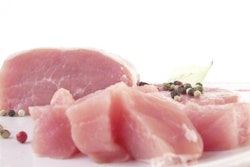
Consistency is critical when making feed ingredients or complete feed products because animal nutrient requirements need to be met at various stages of production for optimal growth performance.
With inadequate or excessive levels of even one key nutrient, growth performance or feed efficiency could be compromised, meaning: increased days to market, more feed consumption and fewer animals sold each year. It could also result in animal mortalities due to toxic levels of a feed additive or rejection of finished product if testing reveals unsafe amounts of a particular chemical residue.
The only way to know whether or not you’re producing consistent ingredients or feeds is to have a quality control system. With well-defined procedures in place, patterns will begin to develop and operators will be able to track product consistency, and more importantly, detect and amend inconsistent products.
Improving quality, minimizing costs with NIR
The use of near-infrared (NIR) spectroscopy has many important characteristics that make it superb as a tool for quality control. Results are obtained within minutes, allowing adjustments to be made immediately. Sample preparation before analysis is minimal or nonexistent because intact samples can be used.
Perhaps the biggest advantage of NIR is repeatability. As long as the NIR machine is working, an unlimited number of samples can be analyzed for no additional cost. This allows large datasets to be generated quickly and added to repeatedly. This is an important characteristic of quality systems and allows for better decision-making.
The main caution with all NIR machines is that the results are only as good as the calibration. A calibration is nothing more than a set of samples that have been analyzed by a reputable laboratory and then scanned by the NIR machine. This relationship between the NIR results and lab values forms the calibration and brings up an important point: NIR machines can never be better than a lab, and building a good calibration is imperative for accurate NIR predictions.
A practical field example: soybean meal
Data from a soybean plant that was using high-shear dry extrusion to rupture cell walls and deactivate antinutrients, followed by mechanical oil pressing to isolate oil, shows the utility of NIR in quality control. The soybean meal from this plant is a major source of amino acids in protein for poultry and livestock diets, and as such, protein was tracked on meal samples using NIR.

Recorded over a 5-week period, the protein in soybean meal samples from a plant using high-shear dry extrusion/mechanical oil pressing equipment showed a notable change in protein concentration. | Insta-Pro International
Several samples from different processing lines were taken each day, but on some days, there were no samples taken. On the surface, this appears to be a consistent line. However, the circled section warrants a deeper look. Something happened during the 48-hour continuous sampling period.

Protein levels were reduced about 4 percentage points during a continuous 48-hour sampling period in samples of soybean meal. | Insta-Pro International
It’s clear that a different soybean meal ingredient was produced. Any nutritionist will confirm that 46 percent protein soybean meal has a different value in a formulation compared with 42 percent protein meal. Examining other NIR data from this same sampling period indicates other differences with the meal.

Moisture and residual oil values were increased during this same 48-hour continuous sampling period in soybean meal samples. | Insta-Pro International
As meal with lower protein was produced, NIR analysis indicated that residual oil and moisture in the meal was increased. Once again, meal with higher moisture and residual oil has a different feeding value.
The increase in moisture content is of interest because moisture content in meal is directly related to temperature in the extruder, and an increase in moisture content could indicate that extrusion was carried out at a lower temperature. Extrusion must be conducted at proper temperatures to effectively deactivate anti-nutrients, so a review of extruder temperatures during this sampling period should be done to ensure that quality meal was produced. Anti-nutrients in soybeans will decrease animal performance.
While the increase in oil is a positive development for a nutritionist or livestock producer (oil is a source of energy), the problem is that without continuous sampling and testing on the NIR, no one would have had any idea that anything changed. Nutritionists formulate diets to achieve certain energy and protein targets, and without consistent-enough ingredients, this will not be possible.
Also, it’s worth pointing out that an increase in residual oil would be viewed negatively for the soy processor. A major goal of most soy processors is to extract as much oil as possible from the beans due to economics. Once again, without constant monitoring, this change would have been missed. Taking samples once or twice a week, and sending to a lab for analysis, likely would not have caught this.

The residual oil levels in samples of soybean meal change over 48 hours. | Insta-Pro International
The previously discussed increase in residual oil is visible and prominent during the 48-hour continuous sampling period. Is there a pattern of increasing, followed by decreasing, residual oil at the beginning of the graph? Does residual oil variation increase more at the end of the sampling period versus the beginning? If the answer to any of these questions is “yes,” then a further investigation is required to have better control over the quality of the meal being produced.
Feed manufacturers can embrace the use of a properly calibrated NIR for quality control systems, especially for consistency with ingredients that will be used to make complete feeds. Periodic sampling and testing can easily miss manufacturing changes that occur over a short time frame. Rather than taking the mindset that generating more data will be problematic and should be avoided, producers should feel empowered to make better decisions and ultimately maintain consistency and quality.

















